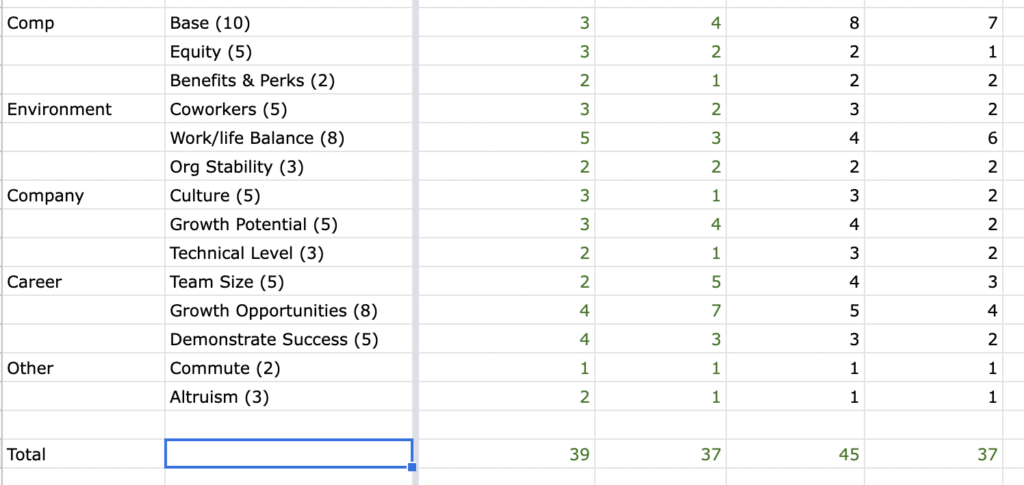It’s 2023, but the layoffs in tech continue unabated from last year, impacting some of the biggest companies in our industry. Fortunately, reports suggest that workers are able to find new jobs within a couple of months of a layoff, as their skills remain in demand amid short supplies of talent.
For those newly looking for work—perhaps having been laid off, or wanting to try something different in the new year—I’ve been sharing versions of the spreadsheet I’ve used for the past decade, for whenever I approach an inflection point in my career and need help choosing a direction. It’s a weighted decision list for jobs, one that I’ve applied in other circumstances with success, and attempts to quantify a complex set of variables into something that feels more tangible. Credit to this toot1 for reminding me to write about a similar system of multi-variate evaluation:
My career decision list is a weighted list of items that are meant to reflect the aspects of your potential roles that are important to you at this moment:
- Start with the major categories. For me, a decade ago, this was: Compensation, Work Environment, Company, Career, and Miscellaneous/Other.
- Criteria within categories (e.g., base salary) are listed on the rows; companies & teams (e.g., Search team within Google, Square) are on the columns. Sometimes I add a column for my current job as a basis for comparison.
- Critically, each criterion has a numeric range reflecting its importance, and the low & high of that range demarcate how much it factors into your decision. More important areas can have a range of 1–10, and less important ones maybe 1–3 or 1–5.
- Of course, most of the input will be guesswork2, and some may be unknowable without being in the role.
- On the last row, sum up that column’s total score. The highest score is your best opportunity.
For example, when I decided to move on from Google → Square, the spreadsheet looked something like this:

A couple of notes to get utility out of this system.
First, much like the aforementioned Job Decision Matrix, this framework only makes sense when it’s personalized to your preferences; the things that matter to you can and do evolve. In the decade that I started to create these spreadsheets, I’ve updated weights and categories to reflect the areas I wanted to focus on, both from a personal and professional standpoint.
The weights give this system a high degree of flexibility without enforcing arbitrary ordering. More often than not, factors that go into a job decision aren’t meaningfully comparable, and I cannot find a good way to definitively put a set of criteria in some absolute stack rank of importance. For example, a decade ago, I cared about joining an altruistic mission as much as not being reorg’ed all the time, which is abstractly less important than joining a rocketship, but it also depends on the strength of that mission. Then again, none of this is scientific; it’s a quantification of a complex set of subjective opinions, broken out into individual parts so they can be reasoned as a standalone dimension.
One final feature—which, in some ways, underlines the subjectiveness of this exercise—is that you can use each opportunity’s total score, objectively sort them in descending order, and then gut-check against that ranking. The first pass often feels off in coming up with a new set of criteria and opportunities: a handful of roles shouldn’t score as high or low as the numbers suggest. I use this to hone in on areas where I haven’t thought hard enough about their weights, if I’m not capturing some piece of information biasing the results, or if I’ve been carrying over assumptions on my internal compass of priorities that need to be reevaluated. It’s a fuzzy, ouroboros feedback loop that nevertheless helps me refine my thinking by laying out the constituent parts.
My brain works by breaking down each factor, building back up to the opportunity, and assigning a subjective quantity to that element that can be mathed to an objective measurement. It’s deeply introspective, but…fun. The numbers also bring a level of psychological finality; once I settle and converge on a matrix with all the wrinkles worked out, I don’t second-guess the answer. So if you’re thinking about the next steps in your career and find yourself lucky enough to entertain multiple opportunities, try using this template to work towards a decision—perhaps en route to crafting your personal evaluation framework.



